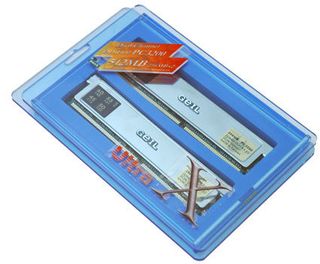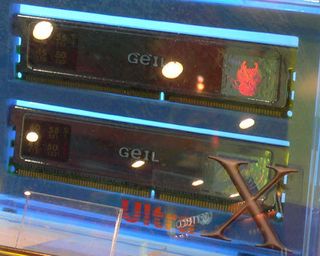The GeIL CL 1.5 DDR600 RAM Promise
Do GeIL's CL1.5 Timings Really Work?

At this year's Computex, Taiwanese memory vendor GeIL (Golden Emperor International, Ltd.) sought to create a sensation with the introduction of its DDR400 memory modules, prominently advertised in their booth as supporting CL1.5-2-2-5 timings. As an optional alternative, this memory also claims to support a clock of 300 MHz (which makes for DDR600 memory speed). GeIL used the well-known tool CPU-Z (from cpuid.org) to prove their points on their in-booth test systems. We weren't content to take them at their word, so we hauled these DIMMs in for our own testing.
Today, these memory modules sell under the brand name GeIL ONE. The samples we received from GeIL were prototypes, but were outfitted with the correct TCCDs. This memory is expensive, and is thus most likely to appeal only to serious enthusiasts. The real question is: Do these further tightenings on memory timing produce tangible performance boosts? Only a few motherboards can handle CAS latency times under 2.0, but it's possible that support for DDR600 might be more appealing because overclocking system and memory clocks for Athlon 64 sytsems is not only reasonably well understood but also reasonably easy to achieve without much additional effort.
The memory modules before us offered 256 MB each; packed very nicely in a good-looking Dual-Channel kit with 2 DIMMs, that gave us 512 MB per kit. Considering GeIL's claims that its DDR400 DIMMs remain stable at higher clock rates without requiring any extra measures, we found that it didn't matter if we bumped the FSB clock or shortened memory timings: Either way, more voltage was required, which raises heat output and ultimately shortens memory lifetimes.
Notwithstanding these findings, we want to tackle only the following question: Are CL1.5 DIMMs really a better value for power users, or is this just another blast of hot air?

The CL1.5 DIMMs were a big hit at GeIL's Computex booth
Stay on the Cutting Edge
Join the experts who read Tom's Hardware for the inside track on enthusiast PC tech news — and have for over 25 years. We'll send breaking news and in-depth reviews of CPUs, GPUs, AI, maker hardware and more straight to your inbox.
Current page: Do GeIL's CL1.5 Timings Really Work?
Next Page Pushing Voltage To The Bitter EndMost Popular

